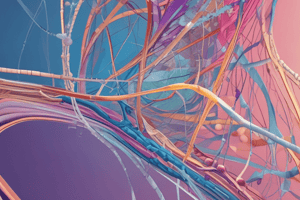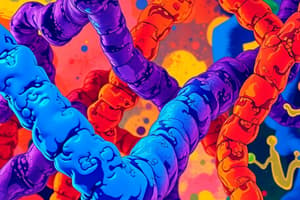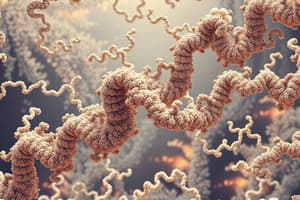Podcast
Questions and Answers
What is the primary sequence characteristic of collagen polypeptides?
What is the primary sequence characteristic of collagen polypeptides?
- Random amino acid sequence without repeats
- Alternating sequence of alanine and glycine
- Repeating tripeptide sequence of X-Y-Gly (correct)
- Repeating tripeptide sequence of Gly-X-Y
In collagen's secondary structure, what unique feature contributes to its helical shape?
In collagen's secondary structure, what unique feature contributes to its helical shape?
- Presence of phenylalanine in every turn
- Hydrogen bonding between all amino acids
- Supercoiling of polypeptide chains
- Glycine residues found in every turn (correct)
How are the three chains in collagen's tertiary structure organized?
How are the three chains in collagen's tertiary structure organized?
- In parallel lines with no interaction
- Randomly dispersed without structure
- In a right-handed superhelical coiled coil (correct)
- In a left-handed helix formation
What consequence does aging have on collagen's structure?
What consequence does aging have on collagen's structure?
Which vitamins are crucial for collagen synthesis through enzyme activation?
Which vitamins are crucial for collagen synthesis through enzyme activation?
What structural change occurs in collagens associated with Osteogenesis imperfecta?
What structural change occurs in collagens associated with Osteogenesis imperfecta?
What role does prolyl hydroxylase play in collagen synthesis?
What role does prolyl hydroxylase play in collagen synthesis?
What results from a mutation in collagen genes associated with Ehlers-Danlos syndrome?
What results from a mutation in collagen genes associated with Ehlers-Danlos syndrome?
What is the primary function of myoglobin (Mb)?
What is the primary function of myoglobin (Mb)?
Which statement correctly describes hemoglobin (Hb)?
Which statement correctly describes hemoglobin (Hb)?
How does the presence of low pH in actively metabolizing tissues affect hemoglobin's function?
How does the presence of low pH in actively metabolizing tissues affect hemoglobin's function?
What role does vitamin C play concerning prolyl hydroxylase?
What role does vitamin C play concerning prolyl hydroxylase?
What characteristic distinguishes elastin's structure?
What characteristic distinguishes elastin's structure?
What is a function of the heme group in proteins?
What is a function of the heme group in proteins?
Which structural feature of hemoglobin allows for positive cooperativity?
Which structural feature of hemoglobin allows for positive cooperativity?
What is the impact of bisphosphoglycerate on hemoglobin's affinity for oxygen?
What is the impact of bisphosphoglycerate on hemoglobin's affinity for oxygen?
What is the primary effect of the hydrophobic patch produced by the hemoglobin defect in sickle cell anemia?
What is the primary effect of the hydrophobic patch produced by the hemoglobin defect in sickle cell anemia?
Which hormone is produced by the β-cells of the Islets of Langerhans in the pancreas?
Which hormone is produced by the β-cells of the Islets of Langerhans in the pancreas?
What is the primary function of glucagon?
What is the primary function of glucagon?
What distinguishes Type 2 diabetes from Type 1 diabetes?
What distinguishes Type 2 diabetes from Type 1 diabetes?
What is the primary structure of an antibody?
What is the primary structure of an antibody?
Which antibody is primarily found in mucosal areas and protects against pathogens?
Which antibody is primarily found in mucosal areas and protects against pathogens?
What role do the variable regions of an antibody serve?
What role do the variable regions of an antibody serve?
Which of the following best describes the function of IgE antibodies?
Which of the following best describes the function of IgE antibodies?
Flashcards are hidden until you start studying
Study Notes
Collagen
- Most abundant protein in mammals
- Insoluble fibers with high tensile strength
- Found in connective tissues including skin, bone, tendon, cartilage, and teeth
- Three polypeptide chains associate in a right-handed superhelical coiled coil structure to form a triple-helical structure (tropocollagen).
- Collagen fibrils are made up of tropocollagen molecules aligned in a staggered fashion and cross-linked for strength.
Collagen: Primary Structure
- Repeating tripeptide sequence of X-Y-Gly
- X can be any amino acid.
- Y is often Pro or Hydroxyproline.
- Lys, 5-Hydroxylysine, and His residues present.
Collagen: Secondary Structure
- Left-handed helix with 3.3 amino acids per turn.
- Gly residues found in every turn, permitting sharp twist of the helix.
- Pitch is 10Å.
Collagen: Tertiary Structure
- Three parallel polypeptide chains associate in a right-handed superhelical coiled coil structure.
- Chains are held together by hydrogen bonds involving hydroxyproline and hydroxylysine.
Collagen: Quaternary Structure
- Collagen fibrils are made up of tropocollagen molecules aligned in a staggered fashion and cross-linked for strength.
- Individual chains of triple-helical collagen molecules and collagen molecules of fibrils are cross-linked by covalent bonds involving Lys, 5-Hydroxylysine, and His residues.
- Increased cross-linking with aging contributes to the brittle properties of aging connective tissue.
Collagen: Diseases caused by defects
- Osteogenesis imperfecta and Ehlers-Danlos syndrome are caused by mutant alleles of collagen genes.
- Often, an amino acid with a relatively large R group such as Cys or Ser replaces Gly residues in mutant collagens, disrupting their structure and function.
- In the synthesis of collagen, ascorbic acid (Vitamin C) is required as a cofactor for the enzyme activities of prolyl hydroxylase and lysyl hydroxylase.
- These enzymes are responsible for the hydroxylation of Pro and Lys in collagen.
- Scurvy results from a deficiency of vitamin C.
Elastin
- Connective tissue protein with elastic properties.
- Found in lungs, walls of large blood vessels, and elastic ligaments.
- Elastin polypeptide chain consists predominantly of nonpolar amino acid residues.
- Elastin fibers associate by desmosine crosslinks.
- Can be stretched to several times their normal length and recoil to original shape when relaxed.
Heme
- Prosthetic group (non-amino acid component required in protein function).
- Consists of Fe2+ bound at the center of protoporphyrin ring.
- Fe2+ has six coordination sites.
- Contributes to the red color of the blood.
Myoglobin
- Single polypeptide chain (153 aa long) with eight -helices.
- Globular protein.
- Single heme group.
- High O2 affinity.
- Primary function is O2 storage.
- Abundant in skeletal muscle.
Hemoglobin
- Tetrameric protein, made up of 2α subunits (141 aa each) and 2β subunits (153 aa each) in a tetrahedral arrangement.
- Each monomer is similar to Mb structure.
- Each subunit has one heme group.
- Hb can bind up to 4 O2 molecules.
- Primary function is O2 transport.
Hemoglobin: Function
- Binds to O2 reversibly and exhibits positive cooperativity.
- Hb’s affinity to O2 increases as more O2 is bound to it.
- Relative to Mb, Hb has low affinity to O2 making it a more efficient O2 carrier than Mb (can easily release O2).
- Factors affecting Hb affinity to O2: pH, presence of CO2, and bisphosphoglycerate.
Oxygen Transport by Hemoglobin
- In actively metabolizing tissue, pH is low decreasing Hb affinity to O2.
- Hb releases O2 and binds to both CO2 and H+.
- In the lungs, pH is high increasing Hb affinity to O2.
- Hb releases both CO2 and H+ and binds oxygen.
Diseases due to Hemoglobin Defects
- Sickle cell anemia is caused by the substitution of Val to Glu on the 6th aa of the β subunit.
- The changed tertiary structure produces a hydrophobic patch on the surface of Hb.
- The hydrophobic patch interacts with other hydrophobic patches causing the Hb to aggregate into strands that align into insoluble fibers.
- Less efficient in delivering O2.
Insulin
- Produced from β-cells of the Islets of Langerhans in the pancreas.
- Made up of two polypeptide chains (51 aa) with inter- and intra-chain disulfide linkage.
- Promotes glucose intake from blood into fat, liver, and skeletal muscle cells (hypoglycemic hormone.)
- Glucose in the cell is converted to glycogen (glycogenesis) or fats (lipogenesis.)
Glucagon
- Produced from α-cells of the Islets of Langerhans in the pancreas.
- Made up of a single polypeptide chain (29 aa).
- Elevates the blood glucose level by promoting synthesis of glucose (gluconeogenesis) and breakdown of glycogen into glucose molecules (glycogenolysis).
- Hyperglycemic hormone.
Insulin Diseases
- Diabetes mellitus
- Type 1: failure of the pancreas to produce enough insulin.
- Type 2: a condition in which cells fail to respond to insulin (insulin resistance).
Antibody (Ab)
- Also known as immunoglobulins.
- Secreted mostly by differentiated B lymphocytes (plasma cells).
- Y-shaped molecule consists of two identical light chains (~25kDa) and two identical heavy chains (~50kDa) held together by disulfide bonds.
- Each chain contains constant and variable regions.
- The variable regions in Ab serve as binding sites (paratope) to the epitope of the antigen.
Antibody Isotypes
- IgA: found in mucosal areas and prevents colonization by pathogens.
- IgD: functions mainly as an antigen receptor on B cells.
- IgE: binds to allergens and triggers histamine release.
Studying That Suits You
Use AI to generate personalized quizzes and flashcards to suit your learning preferences.




